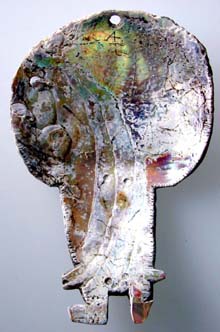 |
 |
 |
|
|
AMS RADIOCARBON DATE
ON A TYPE N1bIII HALIOTIS ORNAMENT FROM CA-SCR-44,
WATSONVILLE, SANTA CRUZ COUNTY, CALIFORNIA
by
Gary S. Breschini and Trudy Haversat
August 5, 2001
 |
 |
 |
|
|
AMS RADIOCARBON DATE
ON A TYPE N1bIII HALIOTIS ORNAMENT FROM CA-SCR-44,
WATSONVILLE, SANTA CRUZ COUNTY, CALIFORNIA
by
Gary S. Breschini and Trudy Haversat
August 5, 2001
A cache of about twelve Type N1bIII Haliotis ornaments was recovered from the St. Francis Church Cemetery area of CA-SCR-44 by cemetery workers during the 1950s. An additional specimen, not among those in the photograph, was loaned to us and is illustrated below. The quality of the photocopied newspaper photograph is not clear enough to distinguish the presence of punctations on those specimens, but punctations are clearly seen on the specimen loaned to us.
Figure 1. Haliotis Ornaments from CA-SCR-44.
The presence of these ornaments at CA-SCR-44 is the first such discovery in the Monterey Bay area.The Type N1bIII Haliotis (abalone) pendants are very distinctive. They are a subtype of Gifford's Type N "Banjo"-type ornaments. "Banjo" ornaments are so named because of their distinctive shape, which resembles a banjo with crude "keys" at one end for tightening the strings and a round body at the other end. All of these ornaments appear to be fashioned from Haliotis rufescens, the red abalone.
Gifford notes that certain specimens with large disks in Types N1a (single lateral projections) and N1b (double lateral projections) resemble the human form, with torso, arms, legs, and an enormous head. He retells Heizer's suggestion to him that these pendants may associate with the "big-head" performances of the Kuksu dances. In these performances the dancers wore a headpiece with tule sticks radiating outward two to three feet, giving the impression of a huge head. Others have also commented on this possibility.

Figures 2 through 5. Haliotis Ornament from CA-SCR-44. Photographs by Trudy Haversat and Gary S. Breschini. Illustration by Anna L. Runnings.
While Haliotis pendants of Gifford's Type N are relatively common throughout Central California (Gifford lists 272 examples, and many additional specimens have been found since his 1947 compendium), the subtype N1bIII, found at CA-SCR-44 appears to be extremely rare (Gifford cited only six examples). Two necessary traits for this type are incised edges and punctations, and the punctations often are not illustrated in the literature, so we cannot be sure whether we are viewing N1bIII pendants or closely related types.Gifford (1947) included only six N1bIII specimens in his exhaustive examination of Californian shell artifacts. Three were reported from CA-CCO-138, one from CA-SAC-6, one from S 28, and one from the Napa region, near Vallejo.
There are a number of other specimens which may be Gifford's Type N1bIII in the literature, but in many cases these specimens are fragmentary or the drawings imprecise. However, at least one specimen with incised edges and punctations is reported at CA-ALA-329 (Coberly 1973: Figure 4; Wilson 1993:275). Numerous other specimens from this site illustrated by Wilson do not appear to have punctations, and so may be closely related types rather than true N1bIII specimens.
Closely related types appear throughout Central California, and typologies are included in charts in Hughes (1994) and Hylkema (n.d.), but the drawings are not sufficiently precise to exactly identify the N1bIII type. Punctations, for example, are often lacking in the small drawings included in charts.
As far as we are aware, these are the first such Type N "banjo" ornaments reported from the Monterey Bay area. It is also likely that the radiocarbon date we obtained represents the first date of the N1bIII type.
Looking at the examples illustrated in Gifford (1947:80) and at the specimen which we had on loan, we find that these punctations are probably of particular importance. They certainly appear, at least on the surface, to be a counting or ranking measure of some kind. Perhaps the number of punctations represents either rank or possibly the number of cycles, such as a dance, that one has participated in.
We find that Gibson and Fenenga (1978:132 in Winter 1978) reached a similar conclusion:
The Phase 1c, 2a pattern of burying sub-adults with markers of high or special status suggests that the effigy ornaments might indicate status by birth, and not personal achievement. There was a prevalent occurrence of effigies with females at Hotchkiss (CCo-138) [Bennyhoff, unpublished notes]. However, a different pattern is apparent in ethnographic descriptions of the Maidu and Patwin where the secret society was open to most males and higher status was not a right by birth but earned by receiving instruction, making payment and in some cases being chosen to replace a person of the highest status [Kroeber 1925:371]. The eastern type of Kuksu cult is found among the Patwin, Salt Pomo, Valley and Hill Maidu, Valley Nisenan and Plains Miwok (Kroeber 1932). Among the Maidu and Patwin the highest rank within the secret society of Kuksu was called the Moki. To become a Moki performer one had to enact all other spirit impersonations. He also attained his post not by any tested proficiency or service within the society, but by having acted as assistant to the individual who was the last incumbent, and having been designated by him as successor [Kroeber 1925:372]. It is possible that certain ceremonial regalia may also have been passed on as well as the title. Among the Patwin some men passed through 12 degrees or stages before attaining the highest rank within the secret society [Kroeber 1925:371]. It is interesting to speculate that the punctations which occur on early Phase 2 Haliotis effigy ornaments marked the particular level which the performer held within the Kuksu or other secret society. The number of punctations occurring on a N1b type ornament varies from 1 to 13 [Gifford 1947].Punctations are also found on other types of Gifford's Type N ornaments, including Types N2bIII (some of which may be N1bIII ornaments cut in half), N2dII, and N3c. It is interesting to note that the majority of these variant specimens with punctations were recovered from CA-CCO-138.
Radiocarbon Date The AMS radiocarbon date obtained from an approximately 0.1 g sample from the back of this pendant is listed in Table 1 below.
Table 1. Radiocarbon Date from a Type N1bIII Haliotis Ornament from CA-SCR-44 (Delta-R = 225 ± 35).
Meas. age Lab. No. Material Provenience C13 Int. 2 sigma cal. 620 ± 40 Beta-141194 Shell-Haliotis -- 1.5 AD 1480 AD 1425-1560
References Breschini, Gary S. and Trudy Haversat. 2000. Archaeological Data Recovery at CA-SCR-44, at the Site of the Lakeview Middle School, Watsonville, Santa Cruz County, California. Coyote Press Archives of California Prehistory 49. Coyote Press, Salinas.Coberly, M.B. 1973. The Archaeology of the Ryan Mound, Site Ala-329, A Central California Coastal Village Site. University of Northern Colorado, Occasional Papers in Anthropology, Archaeological Series 4.
Gibson, Robert O. and Gerritt Fengena. 1978. A Preliminary Analysis of the Shell Beads and Ornaments from CA-SCL-128. In Archaeological Investigations at CA-SCL-128, the Holiday Inn Site, J.C. Winter, ed. Ms. on file, Northwest Regional Information Center of the California Archaeological Inventory, Sonoma State University, Rohnert Park.
Gifford, E.W. 1947. Californian Shell Artifacts. University of California Anthropological Records 9(1):1-114.
Hughes, Richard E., ed. 1994. Toward a New Taxonomic Framework for Central California Archaeology: Essays by James A. Bennyhoff and David A. Fredrickson. Contributions of the University of California Archaeological Research Facility 52.
Hylkema, Mark G. n.d. Tidal Marsh, Oak Woodlands and Cultural Florescence Within the Southern San Francisco Bay Region. In press, University of California, Los Angeles, Archaeological Institute.
Kroeber, A.L. 1925. Handbook of the Indians of California. Bureau of American Ethnology Bulletin 78.
Wilson, G.B. 1993. The Archaeological Collection from CA-ALA-329, the Ryan Mound, Alameda County, California. Coyote Press Archives of California Prehistory 39. Coyote Press, Salinas.
Winter, J.C. 1978. Archaeological Investigations at CA-SCL-128, the Holiday Inn Site. Ms. on file, Northwest Regional Information Center of the California Archaeological Inventory, Sonoma State University, Rohnert Park.
| Copyrights 2025 californiaprehistory.com | Back to the Top |